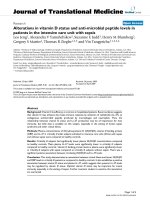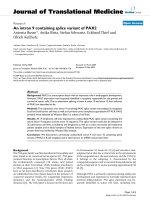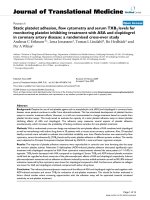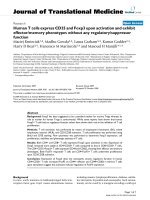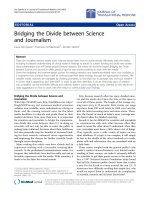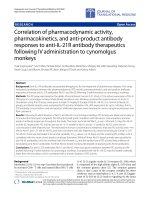Báo cáo hóa học: " Hydrothermally Grown ZnO Micro/Nanotube Arrays and Their Properties" pptx
Bạn đang xem bản rút gọn của tài liệu. Xem và tải ngay bản đầy đủ của tài liệu tại đây (377.91 KB, 6 trang )
NANO EXPRESS
Hydrothermally Grown ZnO Micro/Nanotube Arrays and Their
Properties
Huibo Chen
•
Xiang Wu
•
Lihong Gong
•
Cai Ye
•
Fengyu Qu
•
Guozhen Shen
Received: 20 October 2009 / Accepted: 1 December 2009 / Published online: 16 December 2009
Ó The Author(s) 2009. This article is published with open access at Springerlink.com
Abstract We reported the optical and wettability prop-
erties of aligned zinc oxide micro/nanotube arrays, which
were synthesized on zinc foil via a simple hydrothermal
method. As-synthesized ZnO micro/nanotubes have uni-
form growth directions along the [0001] orientations with
diameters in the range of 100–700 nm. These micro/
nanotubes showed a strong emission peak at 387 nm and
two weak emission peaks at 422 and 485 nm, respectively,
and have the hydrophobic properties with a contact angle
of 121°. Single ZnO micro/nanotube-based field-effect
transistor was also fabricated, which shows typical n-type
semiconducting behavior.
Keywords ZnO Á Nanotubes Á Arrays
Introduction
One-dimensional (1-D) nanostructures become the focus of
current research because of the unique properties related
with their special structures, such as high surface-to-vol-
ume ratios, special compositions, etc. [1–15]. They play
important roles in fabricating nanoscale functional elec-
tronic, optoelectronic, electrochemical, and mechanical
devices. Among the numerous 1-D nanostructures, 1-D
metal oxide nanostructures have been widely investigated
and now have been widely used in many areas, such as
catalysts, sensors, ceramics, transparent oxide conductive
films (TOC) and electronic devices [16–19].
With a wide direct band gap of 3.37 eV and a large
exciton binding energy of 60 meV, zinc oxide (ZnO) [20]
has been attracting attention in both fundamental research
and practical applications and has been considered as a
promising material for gas sensors, varistors, and optical
devices [5, 12]. Many kinds of 1-D ZnO nanostructures
have been synthesized till now, such as nanowires, nano-
tubes, nanobelts, nanorings, nanonails and so on, by many
groups including ours [21–40]. It was found that the
properties of 1-D ZnO nanostructures are affected by many
factors, such as morphologies, compositions, and align-
ments [30–40].
In this paper, we present a simple hydrothermal method
for the synthesis of aligned ZnO micro/nanotube arrays on
zinc foil. These micro/nanotubes have uniform growth
directions along the [0001] orientations with diameters in
the range of 100–700 nm. Room-temperature photolumi-
nescence (PL) properties of these micro/nanotubes were
investigated and they showed a strong emission peak at
387 nm and 2 weak emission peaks at 422 and 485 nm,
respectively. As-synthesized ZnO micro/nanotube arrays
also show hydrophobic properties with a contact angle of
121°. Finally, single micro/nanotube-based field-effect
transistor was also fabricated to investigate their electronic
transport properties.
Experimental Section
All chemical reagents used in the experiment are of ana-
lytical grade and used without further purification. In a
H. Chen Á X. Wu (&) Á L. Gong Á C. Ye Á F. Qu
College of Chemistry and Chemical Engineering, Harbin Normal
University, 150025 Harbin, People’s Republic of China
e-mail:
G. Shen (&)
Wuhan National Laboratory for Optoelectronics and College of
Optoelectronic Science and Engineering, Huazhong University
of Science and Technology, 430074 Wuhan,
People’s Republic of China
e-mail:
123
Nanoscale Res Lett (2010) 5:570–575
DOI 10.1007/s11671-009-9506-4
typical procedure, 5 mmol zinc acetate and equal amount
of hexamethylenetetramine (HMT) were dissolved in
30 ml deionized water under stirring. And then 10 mL
ammonia was put into the above mixed solution. Keeping
stirring for 15 min, the transparent solution was transferred
into a PTFE-lined autoclave with volume of 50 ml. A zinc
foil after ultrasonic treatment was then put into the auto-
clave. After sealed, the autoclave was put in an oven and
heated at 130°C for 7 h. After reaction, the foil was taken
out of the autoclave and washed with water for several
times and then dried in air.
X-ray diffraction (XRD) pattern of the products was
carried out on a D/max-rB of Kaisha X-ray diffractometer
with 2h in the range of 30°–80°. Scanning electron
microscopy (SEM) and energy dispersive spectrometry
(EDS) were taken on a Hitachi S-4800 field-emission
scanning electron microscope equipped with an energy-
dispersion X-ray detector. The microstructures of the
product were investigated using a high-resolution trans-
mission electron microscope (HRTEM, JEM-3000F).
Room-temperature photoluminescence (PL) was curried
out with a SPEX FL-2T2 fluorophotometer with an excited
wavelength of 325 nm. Water contact angle (CA) of the
ZnO micro/nanotube arrays was measured by using a
Dataphysics OCA20 contact angle system at ambient
temperature. All the electrical measurements were carried
out using a semiconductor parameter analyzer (Agilent
4156B apparatus).
Results and Discussion
Figure 1a is a typical SEM image of as-synthesized prod-
uct on zinc foil, which shows the formation of 1-D micro/
nanostructures with good alignments. High-magnification
SEM image shown in Fig. 1b reveals that these 1-D micro/
nanostructures are of tubular structures. Typical micro/
nanotubes have hexagonal shapes with diameters in the
range of 100–700 nm. EDS spectrum depicted in Fig. 1c
shows the peaks of only zinc and oxygen, indicating the
formation of high purity ZnO products. A TEM image of a
single ZnO nanotube with diameter of around 200 nm is
shown in Fig. 1d. The brightness contrast between the
center and the edge indicates the hollow tubular structure,
in agreement with the SEM result. Figure 1e demonstrates
a lattice-resolved HRTEM image taken from the ZnO
nanotube. The clearly resolved lattice fringe is calculated
to be around 0.52 nm, in accordance with the (0001) plane
of hexagonal ZnO crystal. Several tens of nanotubes were
investigated and they all give similar results, indicating that
these nanotubes have preferred growth directions along the
[0001] orientations. Besides ZnO micro/nanotubes, some
ZnO nanowires with smaller diameters were also observed
in Fig. 1a. To investigate the growth process, we per-
formed experiments with short reaction time. Figure 1fisa
SEM image of the product obtained with a reaction time of
2 h. High-density ZnO nanowires with diameters smaller
than 100 nm are formed on the zinc foil. The result indi-
cates that the final ZnO micro/nanotubes may grow on the
base of small ZnO nanowires. In fact, the formation of
micro/nanotubes from small nanowires has already been
observed for several materials, such as ZnO and ZnS
[13, 41].
The crystal structure of the products was also investi-
gated using XRD and the pattern is shown in Fig. 2. In this
pattern, all the sharp diffraction peak can be indexed to
hexagonal wurtzite ZnO phase (JCPDS card No.36-1451)
except those small one labeled with asteroidal notation,
which come from Zn foil used in the experiment. It gives
another evidence for the formation of high purity ZnO
product.
During hydrothermal synthesis of 1-D nanostructures, it
was always found that the salt ions existed in the solution
and the pH values of the solution had great influences on
the final products [42, 43]. Figure 3a, b is the SEM images
of the product obtained when zinc chloride was used
instead of zinc acetate. Flower-like ZnO nanostructures
were found on a large scale on the zinc foil. Each flower
has diameter of around 1 lm and is composed of numerous
small ZnO nanowires. TEM analysis reveals that these
small nanowires are single crystals with the growth direc-
tions along the [0001] orientations. Figure 3c is the SEM
image of a product obtained under different pH value by
using NaOH instead of HMT. Though ZnO nanoflowers
were also obtained under this condition as those shown in
Fig. 3b, high-magnification SEM image shown in Fig. 3d
reveals that they have quite different microstructures. The
nanoflowers obtained by using NaOH are composed of
numerous ZnO nanoplates instead of nanowires in Fig. 3b.
Typical ZnO nanoplate has a thickness of several tens of
nanometers. It was thought that the strong pH values
changed the growth rates of different crystal planes and
thus resulted in the formation of different structures.
To investigate the optical properties of these micro/
nanotubes, room-temperature photoluminescence was
conducted and a typical spectrum was shown in Fig. 4.
From this spectrum, it can be seen that the ZnO micro/
nanotube arrays show a sharp and strong emission peak
centered at approximately 387 nm, which corresponds to
the near-band-edge peak that is responsible for the
recombination of free excitons through an exciton-exciton
collision process [44, 45]. Besides the near-band-edge
emission, another two emissions centered at around 422
and 485 nm were also observed in the spectrum, which are
the deep-level emissions according to the literature. They
are related to the singly ionized oxygen vacancies, and are
Nanoscale Res Lett (2010) 5:570–575 571
123
resulted from the recombination of a photogenerated hole
with a singly ionized charge state of specific defects
[46, 47].
Wettability of nanostructures has attracted great inter-
ests in recent years and it is one of the most important
properties of nanostructures, which is usually governed by
both the chemical composition and the geometrical struc-
ture of the solid surfaces. Wettability of 1-D ZnO nano-
structures with different morphologies has been studied and
the results revealed that different ZnO nanostructures have
quite different wettabilities, such as hydrophobic, super-
hydrophobic, or hydrophilic properties [48–51]. We also
studied the wettability of our aligned ZnO micro/nanotube
arrays by checking the water contract angle on the surface.
Figure 5 is a water contact angle picture. A contact angle
of 121° is observed for the aligned ZnO micro/nanotube
arrays, indicating that the product has a hydrophobic
property, which may find applications in self-cleaning and
photocatalytic fields. The high water contact angle is
believed to be caused by the low surface energy of the
(0001) plane at the micro/nanotube surface combined with
the feature size of the sample [48].
Single micro/nanotube-based field-effect transistors
were then fabricated according to our previous reported
technique [52–54]. Briefly, the synthesized ZnO micro/
nanotubes were first sonicated into a suspension in iso-
propanol (IPA) and then deposited onto a degenerately
doped silicon wafer covered with 500 nm SiO
2
.
Fig. 1 a, b SEM images, c EDS
spectrum, d TEM image and e
HRTEM image of as-
synthesized ZnO micro/
nanotubes. f SEM image of
aligned ZnO nanowire arrays
synthesized for short time
Fig. 2 XRD pattern of as-synthesized ZnO micro/nanotube arrays
572 Nanoscale Res Lett (2010) 5:570–575
123
Photolithography was then performed, followed by Ti/Au
(5 nm/100 nm) deposition to pattern the source and drain
electrodes on both ends of the ZnO micro/nanotubes. Fig-
ure 6a inset is a top view SEM image of the fabricated
single-nanotube-device. The channel length between the
source and the drain electrodes of the device is 2 lm.
Figure 6a shows the typical gate-dependent current–volt-
age (I–V) curves obtained from the device in air. Linear
current versus voltage was observed for the device, indi-
cating the good Ohmic contacts to structure. The applied
gate voltages to the device range from -20 to 20 V. The
transport data clearly show decrease in conductance for
V
g
\ 0, whereas the conductance increases for V
g
[ 0,
indicating that the present ZnO micro/nanotubes are of
typical n-type semiconducting behavior. The gate effect is
relative weak, which is believed to be caused by the
existence of high-density defect sites within the micro/
nanotubes. The I
ds
–V
g
curve was also measured and the
result was shown in Fig. 6b. For a given V
ds
, I
ds
decreases
with increasing negative V
g
, also implies that the ZnO
micro/nanotube are an n-type semiconducting material.
Fig. 4 Room-temperature photoluminescence spectrum of the
synthesized ZnO micro/nanotube arrays
Fig. 5 Typical shape of a water droplet on as-grown ZnO micro/
nanotube arrays
Fig. 3 SEM images of ZnO
products obtained at different
conditions. a, b ZnO
nanoflowers composed of ZnO
nanowires. c, d ZnO
nanoflowers composed of ZnO
nanoplates
Nanoscale Res Lett (2010) 5:570–575 573
123
Conclusion
In summary, ZnO micro/nanotube arrays have been suc-
cessfully synthesized via a simple hydrothermal method on
a zinc foil substrate. As-synthesized micro/nanotubes are
single crystals with growth directions along the [0001]
orientations. These micro/nanotubes show strong near-
band-edge emission at 387 nm and weak defects-related
emissions at 422 and 485 nm, respectively. Contact angle
result indicates they have good hydrophobic properties.
Field-effect transistors were fabricated based on the ZnO
micro/nanotubes, which show n-type semiconducting
characteristics. Our results show that the hydrothermally
synthesized ZnO micro/nanotubes may be used as self-
cleaning photocatalysts as well as building blocks for
nanoscale electronic and optoelectronic devices.
Acknowledgments This work was supported by the High-level
Talent Recruitment Foundation of Huazhong University of Science
and Technology, the Basic Scientific Research Funds for Central
Colleges (Q2009043), the Natural Science Foundation of Hubei
Province (2009CDB326), the Doctor Start-up Fund of Harbin Normal
University (KGB200802), the National Natural Science Foundation of
China (20871037), the Natural Science Foundation of Heilongjiang
Province (B2007-2) and the Science Technology and Research Pro-
ject of Education Bureau, Heilongjiang Province (11531229,
12531236).
Open Access This article is distributed under the terms of the
Creative Commons Attribution Noncommercial License which per-
mits any noncommercial use, distribution, and reproduction in any
medium, provided the original author(s) and source are credited.
References
1. C.M. Lieber, Z.L. Wang, MRS Bull. 32, 99 (2007)
2. Y.N. Xia, P. Yang, Y. Sun, Y. Wu, B. Mayers, B. Gates, Y. Yin,
F. Kim, H. Yan, Adv. Mater. 15, 353 (2003)
3. G.Z. Shen, D. Chen, J. Am. Chem. Soc. 128, 11762 (2006)
4. G.Z. Shen, Y. Bando, C. Ye, X. Yuan, T. Sekiguchi, D. Golberg,
Angew. Chem. Int. Ed. 45, 7568 (2006)
5. Z.W. Pan, Z.R. Dai, Z.L. Wang, Science 291, 1947 (2001)
6. G.Z. Shen, J.H. Cho, J.K. Yoo, G.C. Yi, C.J. Lee, J. Phys. Chem.
B 109, 9294 (2005)
7. J.G. Lu, P. Chang, Z. Fan, Mater. Sci. Eng. R 52, 49 (2006)
8. G.Z. Shen, Y. Bando, J.H. Hu, D. Golberg, Appl. Phys. Lett. 90,
123101 (2007)
9. Y. Sun, J.A. Rogers, J. Mater. Chem. 17, 832 (2007)
10. L. Samuelson, Mater. Today 6, 22 (2003)
11. G.Z. Shen, D. Chen, Nanoscale Res. Lett. 4, 779 (2009)
12. Z.L. Wang, Nanowires and Nanobelts (Kluwer, New York, 2003)
13. G.Z. Shen, Y. Bando, D. Golberg, Appl. Phys. Lett. 88, 123107
(2006)
14. L.J. Lauhon, M.S. Gudiksen, D. Wang, C.M. Lieber, Nature 420,
57 (2002)
15. Q. Li, C.R. Wang, Appl. Phys. Lett 82, 1398 (2003)
16. P. Yang, H. Yan, S. Mao, R. Russo, J. Johnson, R. Saykally, N.
Morris, J. Pham, R. He, J. Cho, Adv. Funct. Mater. 12, 323 (2002)
17. Y. Wang, X. Jiang, Y.N. Xia, J. Am. Chem. Soc. 125, 16176
(2003)
18. C. Li, D. Zhang, S. Han, X. Liu, T. Tang, C. Zhou, Adv. Mater.
15, 143 (2003)
19. Y. Kobayashi, H. Hata, M. Salama, T.E. Mallouk, Nano Lett. 7,
2142 (2007)
20. S. Liang, H. Sheng, Y. Liu, Z. Hio, Y. Lu, H. Shen, J. Cryst.
Growth 225, 110 (2001)
21. G.Z. Shen, D. Chen, C.J. Lee, J. Phys. Chem. B 110, 15689
(2006)
22. Z.L. Wang, Mater. Sci. Eng. R 64, 3 (2009)
23. G.Z. Shen, Y. Bando, B. Liu, D. Golberg, C.J. Lee, Adv. Funct.
Mater. 16, 410 (2006)
24. W.I. Park, J.S. Kim, G.C. Yi, H.J. Lee, Adv. Mater. 17, 1393
(2005)
25. G.C. Yi, C. Wang, W.I. Park, Semicond. Sci. Technol. 20, S22
(2005)
26. G.Z. Shen, Y. Bando, D. Chen, B. Liu, C. Zhi, D. Golberg, J.
Phys. Chem. B 110, 3973 (2006)
27. G.Z. Shen, Y. Bando, C.J. Lee, J. Phys. Chem. B 109, 10779
(2005)
28. Z.L. Wang, X. Kong, Y. Ding, P. Gao, W.L. Hughes, R. Yang, Y.
Zhang, Adv. Funct. Mater. 14, 943 (2004)
29. Z. Zhu, T.L. Chen, Y. Gu, J. Warren, R.M. Osgood, Chem.
Mater. 17, 4227 (2005)
Fig. 6 a Typical I
ds
–V
ds
curves obtained at different gate voltages
and b I
ds
–V
g
curve of a single ZnO nanotube FET. The inset is a SEM
image of the device
574 Nanoscale Res Lett (2010) 5:570–575
123
30. G.Z. Shen, Y. Bando, C.J. Lee, J. Phys. Chem. B 109, 10578
(2005)
31. M. Huang, S. Feick, H. Yan, Y. Wu, H. Kind, E. Weber, R.
Russo, P. Yang, Science 292, 1897 (2001)
32. G.Z. Shen, J. Cho, J.K. Yoo, G.C. Yi, C.J. Lee, J. Phys. Chem. B
109, 5491 (2005)
33. L. Vayssieres, K. Keis, A. Hagfeldt, S.E. Lindquist, Chem. Mater.
13, 4395 (2001)
34. G.Z. Shen, J. Cho, S.I. Jung, C.J. Lee, Chem. Phys. Lett. 401, 529
(2005)
35. M. Mo, J.C. Yu, L.Z. Zhang, S.K. Li, Adv. Mater. 17, 756 (2005)
36. G.Z. Shen, J. Cho, C.J. Lee, Chem. Phys. Lett. 401, 414 (2005)
37. H. Ham, G.Z. Shen, J. Cho, T. Lee, S. Seo, C.J. Lee, Chem. Phys.
Lett. 404, 69 (2005)
38. X.Y. Kong, Y. Ding, R. Yang, Z.L. Wang, Science 303, 1348
(2004)
39. J.J. Wu, S.C. Liu, Adv. Mater. 14, 215 (2002)
40. U.K. Gautam, L.S. Panchakarla, B. Dierre, X. Fang, Y. Bando, T.
Sekiguchi, A. Govindaraj, D. Golberg, C.N.R. Rao, Adv. Funct.
Mater. 19, 131 (2009)
41. J.S. Jeong, J.Y. Lee, J.H. Cho, H.J. Suh, C.J. Lee, Chem. Mater.
17, 2752 (2005)
42. D. Chen, J. Ye, Chem. Mater. 19, 4585 (2007)
43. D. Chen, K. Tang, F. Li, H. Zheng, Cryst. Growth & Design 6,
247 (2006)
44. S.C. Lyu, Y. Zhang, H. Ruh, H.J. Lee, H.W. Shim, E.K. Suh, C.J.
Lee, Chem. Phys. Lett. 363, 134 (2002)
45. E.M. Wong, P.C. Searson, Appl. Phys. Lett. 74, 2939 (1999)
46. R. Konenkamp, R.C. Word, C. Schlegel, Appl. Phys. Lett. 85,
6004 (2004)
47. B. Jin, S. Bae, S. Lee, S. Im, Mater. Sci. Eng. B 71, 301 (2000)
48. G. Kenanakis, E. Stratakis, K. Vlachou, D. Vernardou, E. Kou-
doumas, N. Katsarakis, Appl. Surf. Sci. 254, 5695 (2008)
49. B. Xu, Z. Cai, Appl. Surf. Sci. 254, 5899 (2008)
50. Y. Yang, Z. Li, B. Wang, C. Wang, D. Chen, G. Yang, J. Phys.
Condens. Matter. 17, 5441 (2005)
51. X. Meng, D. Zhao, J. Zhang, D. Shen, Y. Lu, L. Dong, Z. Xiao,
Y. Liu, X. Fan, Chem. Phys. Lett. 413, 450 (2005)
52. X. Liu, C. Li, S. Han, J. Han, C. Zhou, Appl. Phys. Lett. 82, 996
(2003)
53. G.Z. Shen, P.C. Chen, Y. Bando, D. Golberg, C. Zhou, Chem.
Mater. 20, 7319 (2008)
54. G.Z. Shen, P.C. Chen, Y. Bando, D. Golberg, C. Zhou, Chem.
Mater. 20, 6779 (2008)
Nanoscale Res Lett (2010) 5:570–575 575
123

